Essay: Measuring Technological Progress and Societal Evolution
VerifiedAdded on 2022/09/27
|5
|1161
|18
Essay
AI Summary
This essay delves into the concept of technological progress by examining the viewpoints of Gerhard Lenski, Leslie White, and Alvin Toffler. Lenski's perspective highlights the role of technological advancement as a driving force in the evolution of human civilization, emphasizing adaptation to environmental changes and the importance of information. White's perspective focuses on the ability to control and harness energy as the key factor in technological evolution, linking it to cultural development. Toffler's perspective introduces the concept of future shock, arguing for the need for individuals to adapt to rapid technological and social changes, and delineates societal development into agrarian, industrial, and postindustrial stages. The essay provides a comparative analysis of these three perspectives, highlighting their strengths and limitations in understanding the relationship between technology and society.
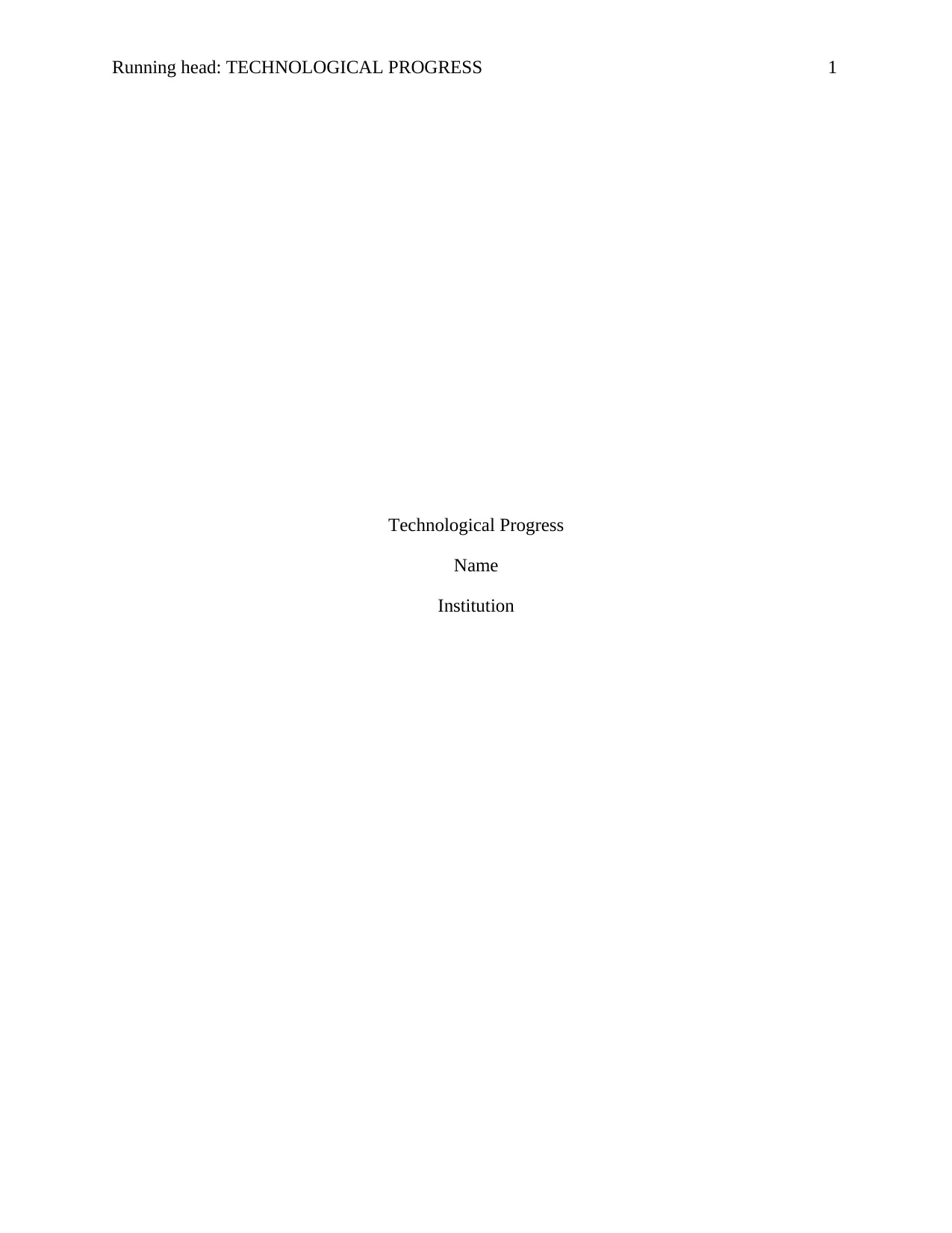
Running head: TECHNOLOGICAL PROGRESS 1
Technological Progress
Name
Institution
Technological Progress
Name
Institution
Paraphrase This Document
Need a fresh take? Get an instant paraphrase of this document with our AI Paraphraser
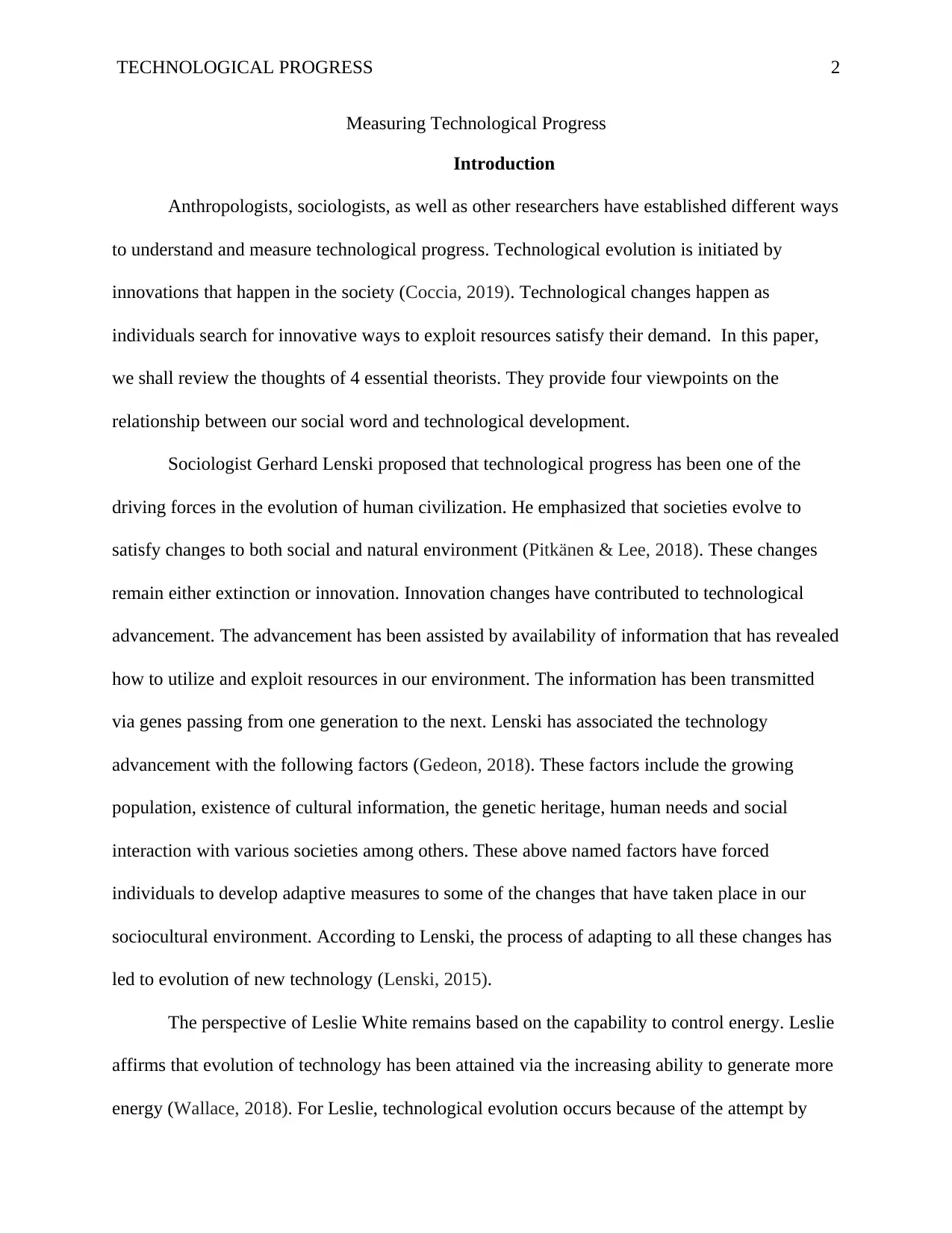
TECHNOLOGICAL PROGRESS 2
Measuring Technological Progress
Introduction
Anthropologists, sociologists, as well as other researchers have established different ways
to understand and measure technological progress. Technological evolution is initiated by
innovations that happen in the society (Coccia, 2019). Technological changes happen as
individuals search for innovative ways to exploit resources satisfy their demand. In this paper,
we shall review the thoughts of 4 essential theorists. They provide four viewpoints on the
relationship between our social word and technological development.
Sociologist Gerhard Lenski proposed that technological progress has been one of the
driving forces in the evolution of human civilization. He emphasized that societies evolve to
satisfy changes to both social and natural environment (Pitkänen & Lee, 2018). These changes
remain either extinction or innovation. Innovation changes have contributed to technological
advancement. The advancement has been assisted by availability of information that has revealed
how to utilize and exploit resources in our environment. The information has been transmitted
via genes passing from one generation to the next. Lenski has associated the technology
advancement with the following factors (Gedeon, 2018). These factors include the growing
population, existence of cultural information, the genetic heritage, human needs and social
interaction with various societies among others. These above named factors have forced
individuals to develop adaptive measures to some of the changes that have taken place in our
sociocultural environment. According to Lenski, the process of adapting to all these changes has
led to evolution of new technology (Lenski, 2015).
The perspective of Leslie White remains based on the capability to control energy. Leslie
affirms that evolution of technology has been attained via the increasing ability to generate more
energy (Wallace, 2018). For Leslie, technological evolution occurs because of the attempt by
Measuring Technological Progress
Introduction
Anthropologists, sociologists, as well as other researchers have established different ways
to understand and measure technological progress. Technological evolution is initiated by
innovations that happen in the society (Coccia, 2019). Technological changes happen as
individuals search for innovative ways to exploit resources satisfy their demand. In this paper,
we shall review the thoughts of 4 essential theorists. They provide four viewpoints on the
relationship between our social word and technological development.
Sociologist Gerhard Lenski proposed that technological progress has been one of the
driving forces in the evolution of human civilization. He emphasized that societies evolve to
satisfy changes to both social and natural environment (Pitkänen & Lee, 2018). These changes
remain either extinction or innovation. Innovation changes have contributed to technological
advancement. The advancement has been assisted by availability of information that has revealed
how to utilize and exploit resources in our environment. The information has been transmitted
via genes passing from one generation to the next. Lenski has associated the technology
advancement with the following factors (Gedeon, 2018). These factors include the growing
population, existence of cultural information, the genetic heritage, human needs and social
interaction with various societies among others. These above named factors have forced
individuals to develop adaptive measures to some of the changes that have taken place in our
sociocultural environment. According to Lenski, the process of adapting to all these changes has
led to evolution of new technology (Lenski, 2015).
The perspective of Leslie White remains based on the capability to control energy. Leslie
affirms that evolution of technology has been attained via the increasing ability to generate more
energy (Wallace, 2018). For Leslie, technological evolution occurs because of the attempt by
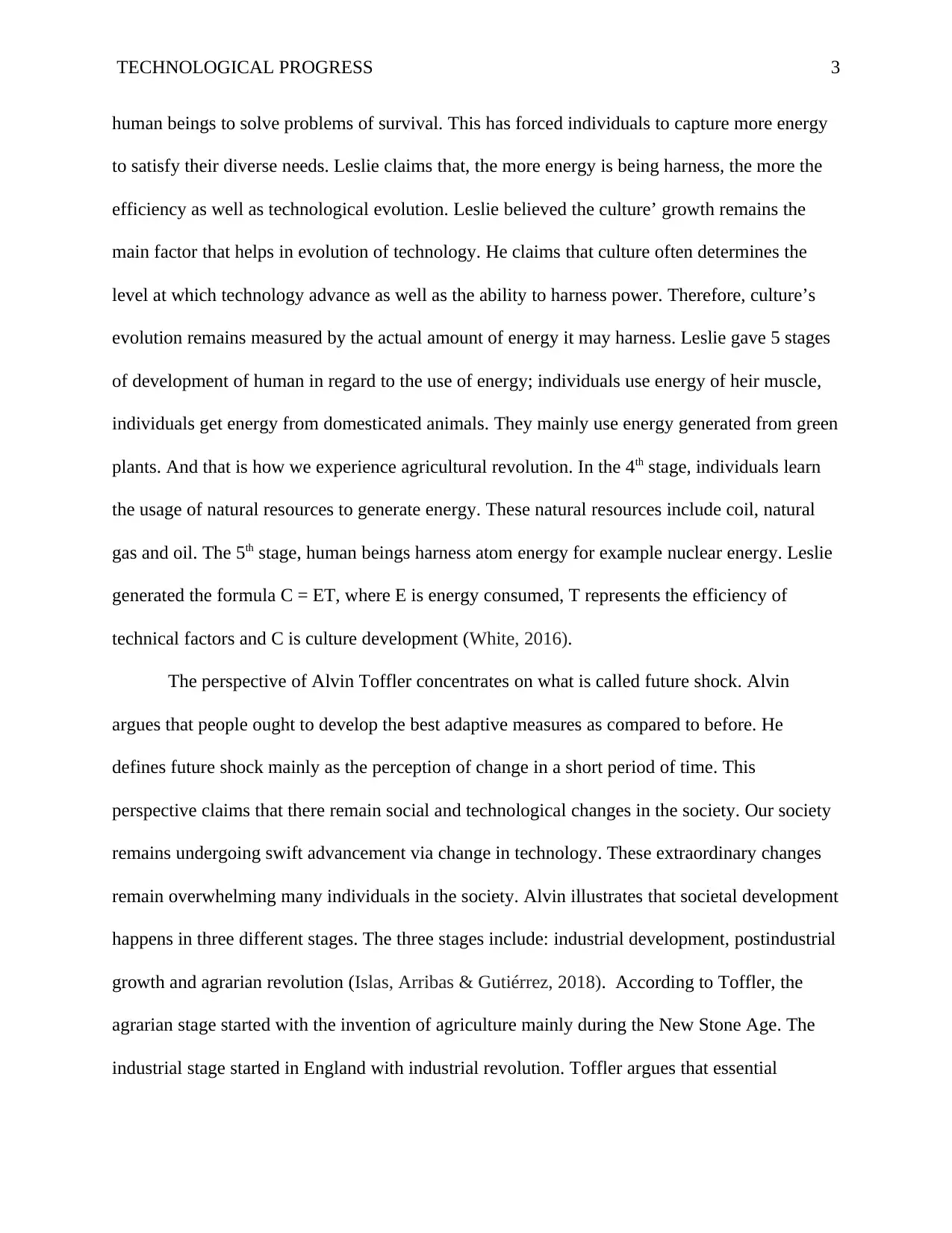
TECHNOLOGICAL PROGRESS 3
human beings to solve problems of survival. This has forced individuals to capture more energy
to satisfy their diverse needs. Leslie claims that, the more energy is being harness, the more the
efficiency as well as technological evolution. Leslie believed the culture’ growth remains the
main factor that helps in evolution of technology. He claims that culture often determines the
level at which technology advance as well as the ability to harness power. Therefore, culture’s
evolution remains measured by the actual amount of energy it may harness. Leslie gave 5 stages
of development of human in regard to the use of energy; individuals use energy of heir muscle,
individuals get energy from domesticated animals. They mainly use energy generated from green
plants. And that is how we experience agricultural revolution. In the 4th stage, individuals learn
the usage of natural resources to generate energy. These natural resources include coil, natural
gas and oil. The 5th stage, human beings harness atom energy for example nuclear energy. Leslie
generated the formula C = ET, where E is energy consumed, T represents the efficiency of
technical factors and C is culture development (White, 2016).
The perspective of Alvin Toffler concentrates on what is called future shock. Alvin
argues that people ought to develop the best adaptive measures as compared to before. He
defines future shock mainly as the perception of change in a short period of time. This
perspective claims that there remain social and technological changes in the society. Our society
remains undergoing swift advancement via change in technology. These extraordinary changes
remain overwhelming many individuals in the society. Alvin illustrates that societal development
happens in three different stages. The three stages include: industrial development, postindustrial
growth and agrarian revolution (Islas, Arribas & Gutiérrez, 2018). According to Toffler, the
agrarian stage started with the invention of agriculture mainly during the New Stone Age. The
industrial stage started in England with industrial revolution. Toffler argues that essential
human beings to solve problems of survival. This has forced individuals to capture more energy
to satisfy their diverse needs. Leslie claims that, the more energy is being harness, the more the
efficiency as well as technological evolution. Leslie believed the culture’ growth remains the
main factor that helps in evolution of technology. He claims that culture often determines the
level at which technology advance as well as the ability to harness power. Therefore, culture’s
evolution remains measured by the actual amount of energy it may harness. Leslie gave 5 stages
of development of human in regard to the use of energy; individuals use energy of heir muscle,
individuals get energy from domesticated animals. They mainly use energy generated from green
plants. And that is how we experience agricultural revolution. In the 4th stage, individuals learn
the usage of natural resources to generate energy. These natural resources include coil, natural
gas and oil. The 5th stage, human beings harness atom energy for example nuclear energy. Leslie
generated the formula C = ET, where E is energy consumed, T represents the efficiency of
technical factors and C is culture development (White, 2016).
The perspective of Alvin Toffler concentrates on what is called future shock. Alvin
argues that people ought to develop the best adaptive measures as compared to before. He
defines future shock mainly as the perception of change in a short period of time. This
perspective claims that there remain social and technological changes in the society. Our society
remains undergoing swift advancement via change in technology. These extraordinary changes
remain overwhelming many individuals in the society. Alvin illustrates that societal development
happens in three different stages. The three stages include: industrial development, postindustrial
growth and agrarian revolution (Islas, Arribas & Gutiérrez, 2018). According to Toffler, the
agrarian stage started with the invention of agriculture mainly during the New Stone Age. The
industrial stage started in England with industrial revolution. Toffler argues that essential
⊘ This is a preview!⊘
Do you want full access?
Subscribe today to unlock all pages.

Trusted by 1+ million students worldwide
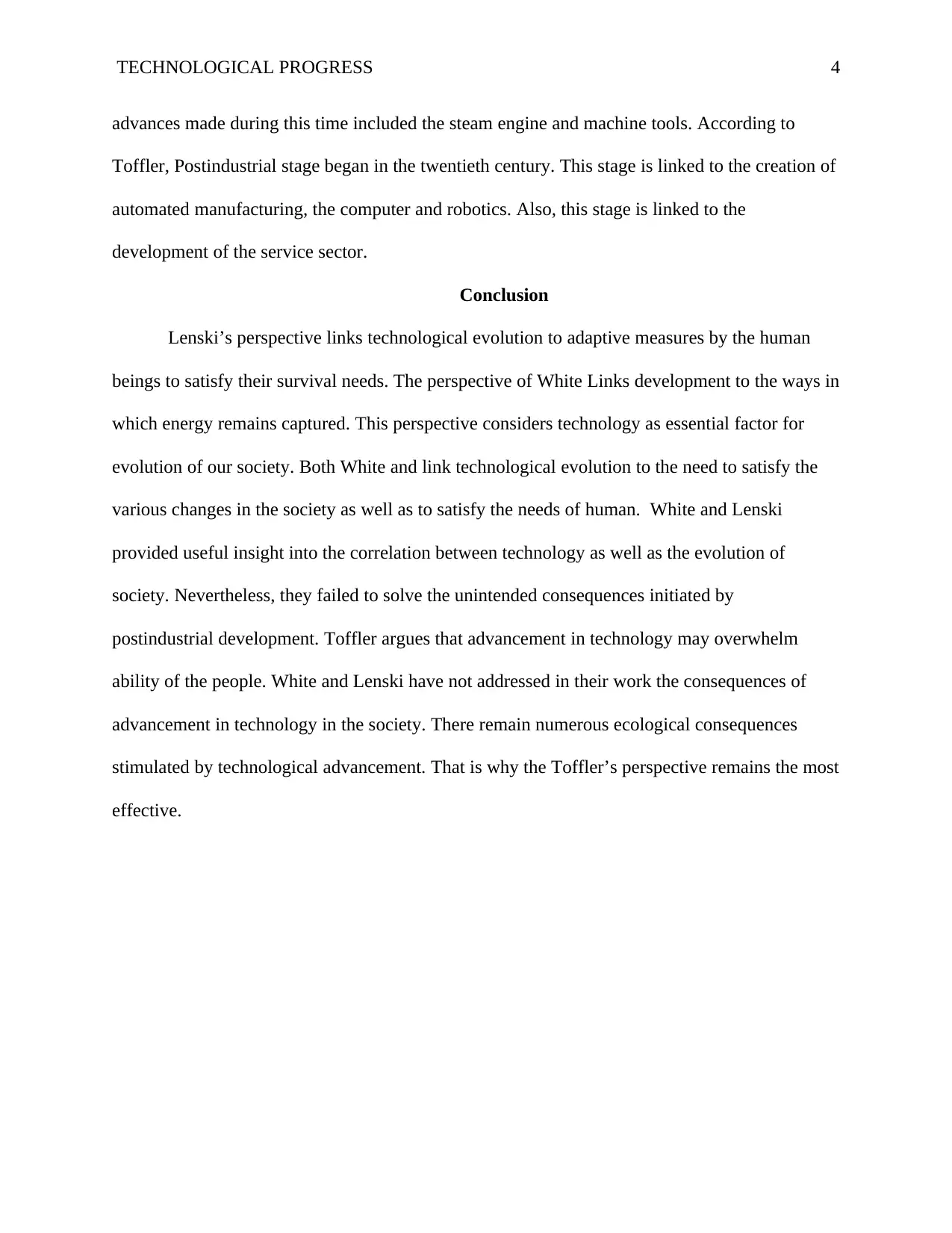
TECHNOLOGICAL PROGRESS 4
advances made during this time included the steam engine and machine tools. According to
Toffler, Postindustrial stage began in the twentieth century. This stage is linked to the creation of
automated manufacturing, the computer and robotics. Also, this stage is linked to the
development of the service sector.
Conclusion
Lenski’s perspective links technological evolution to adaptive measures by the human
beings to satisfy their survival needs. The perspective of White Links development to the ways in
which energy remains captured. This perspective considers technology as essential factor for
evolution of our society. Both White and link technological evolution to the need to satisfy the
various changes in the society as well as to satisfy the needs of human. White and Lenski
provided useful insight into the correlation between technology as well as the evolution of
society. Nevertheless, they failed to solve the unintended consequences initiated by
postindustrial development. Toffler argues that advancement in technology may overwhelm
ability of the people. White and Lenski have not addressed in their work the consequences of
advancement in technology in the society. There remain numerous ecological consequences
stimulated by technological advancement. That is why the Toffler’s perspective remains the most
effective.
advances made during this time included the steam engine and machine tools. According to
Toffler, Postindustrial stage began in the twentieth century. This stage is linked to the creation of
automated manufacturing, the computer and robotics. Also, this stage is linked to the
development of the service sector.
Conclusion
Lenski’s perspective links technological evolution to adaptive measures by the human
beings to satisfy their survival needs. The perspective of White Links development to the ways in
which energy remains captured. This perspective considers technology as essential factor for
evolution of our society. Both White and link technological evolution to the need to satisfy the
various changes in the society as well as to satisfy the needs of human. White and Lenski
provided useful insight into the correlation between technology as well as the evolution of
society. Nevertheless, they failed to solve the unintended consequences initiated by
postindustrial development. Toffler argues that advancement in technology may overwhelm
ability of the people. White and Lenski have not addressed in their work the consequences of
advancement in technology in the society. There remain numerous ecological consequences
stimulated by technological advancement. That is why the Toffler’s perspective remains the most
effective.
Paraphrase This Document
Need a fresh take? Get an instant paraphrase of this document with our AI Paraphraser
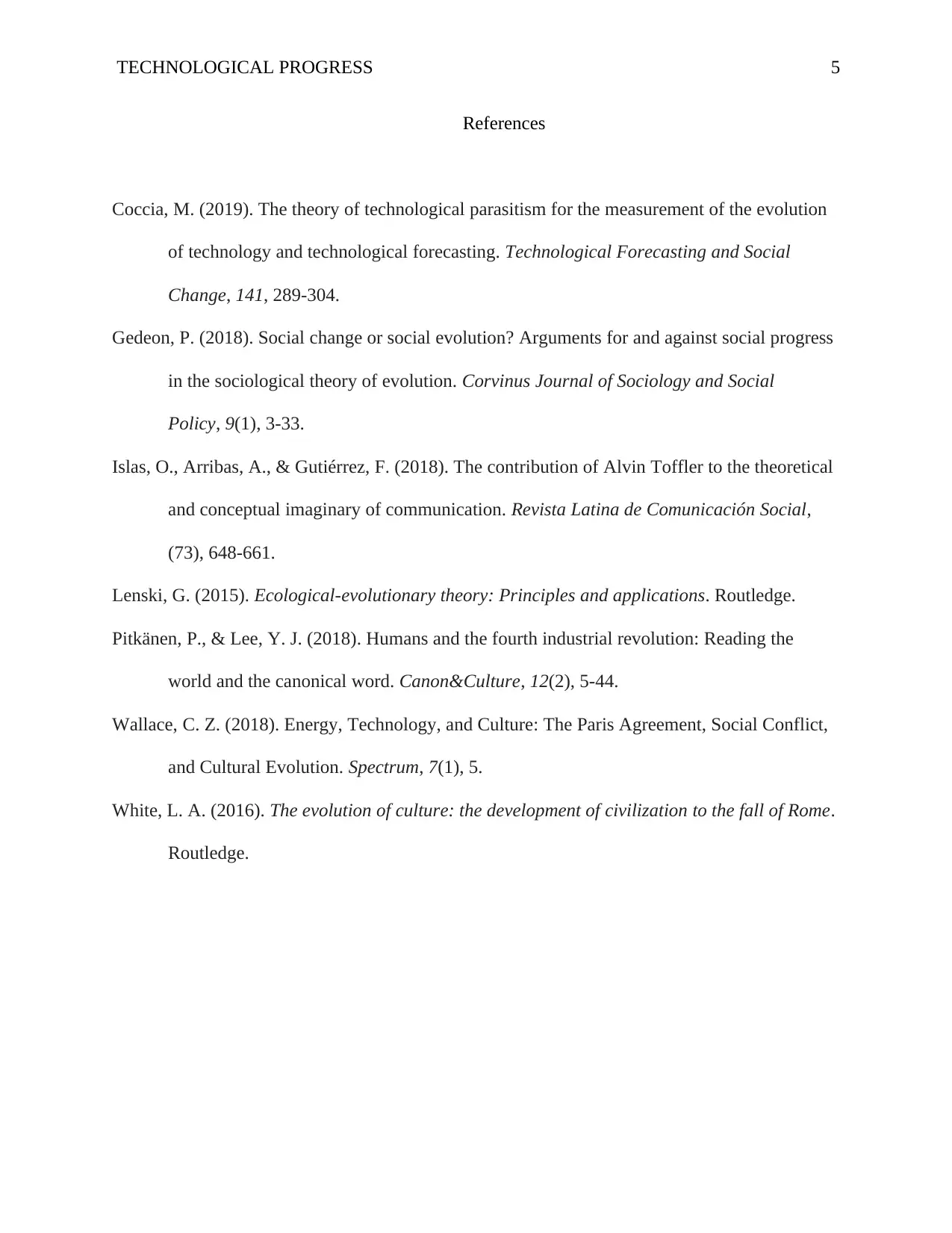
TECHNOLOGICAL PROGRESS 5
References
Coccia, M. (2019). The theory of technological parasitism for the measurement of the evolution
of technology and technological forecasting. Technological Forecasting and Social
Change, 141, 289-304.
Gedeon, P. (2018). Social change or social evolution? Arguments for and against social progress
in the sociological theory of evolution. Corvinus Journal of Sociology and Social
Policy, 9(1), 3-33.
Islas, O., Arribas, A., & Gutiérrez, F. (2018). The contribution of Alvin Toffler to the theoretical
and conceptual imaginary of communication. Revista Latina de Comunicación Social,
(73), 648-661.
Lenski, G. (2015). Ecological-evolutionary theory: Principles and applications. Routledge.
Pitkänen, P., & Lee, Y. J. (2018). Humans and the fourth industrial revolution: Reading the
world and the canonical word. Canon&Culture, 12(2), 5-44.
Wallace, C. Z. (2018). Energy, Technology, and Culture: The Paris Agreement, Social Conflict,
and Cultural Evolution. Spectrum, 7(1), 5.
White, L. A. (2016). The evolution of culture: the development of civilization to the fall of Rome.
Routledge.
References
Coccia, M. (2019). The theory of technological parasitism for the measurement of the evolution
of technology and technological forecasting. Technological Forecasting and Social
Change, 141, 289-304.
Gedeon, P. (2018). Social change or social evolution? Arguments for and against social progress
in the sociological theory of evolution. Corvinus Journal of Sociology and Social
Policy, 9(1), 3-33.
Islas, O., Arribas, A., & Gutiérrez, F. (2018). The contribution of Alvin Toffler to the theoretical
and conceptual imaginary of communication. Revista Latina de Comunicación Social,
(73), 648-661.
Lenski, G. (2015). Ecological-evolutionary theory: Principles and applications. Routledge.
Pitkänen, P., & Lee, Y. J. (2018). Humans and the fourth industrial revolution: Reading the
world and the canonical word. Canon&Culture, 12(2), 5-44.
Wallace, C. Z. (2018). Energy, Technology, and Culture: The Paris Agreement, Social Conflict,
and Cultural Evolution. Spectrum, 7(1), 5.
White, L. A. (2016). The evolution of culture: the development of civilization to the fall of Rome.
Routledge.
1 out of 5
Related Documents
Your All-in-One AI-Powered Toolkit for Academic Success.
+13062052269
info@desklib.com
Available 24*7 on WhatsApp / Email
![[object Object]](/_next/static/media/star-bottom.7253800d.svg)
Unlock your academic potential
Copyright © 2020–2025 A2Z Services. All Rights Reserved. Developed and managed by ZUCOL.





